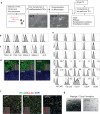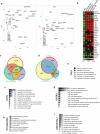Direct induction of haematoendothelial programs in human pluripotent stem cells by transcriptional regulators
- PMID: 25019369
- PMCID: PMC4107340
- DOI: 10.1038/ncomms5372
Direct induction of haematoendothelial programs in human pluripotent stem cells by transcriptional regulators
Abstract
Advancing pluripotent stem cell technologies for modelling haematopoietic stem cell development and blood therapies requires identifying key regulators of haematopoietic commitment from human pluripotent stem cells (hPSCs). Here, by screening the effect of 27 candidate factors, we reveal two groups of transcriptional regulators capable of inducing distinct haematopoietic programs from hPSCs: pan-myeloid (ETV2 and GATA2) and erythro-megakaryocytic (GATA2 and TAL1). In both cases, these transcription factors directly convert hPSCs to endothelium, which subsequently transform into blood cells with pan-myeloid or erythro-megakaryocytic potential. These data demonstrate that two distinct genetic programs regulate the haematopoietic development from hPSCs and that both of these programs specify hPSCs directly to haemogenic endothelial cells. In addition, this study provides a novel method for the efficient induction of blood and endothelial cells from hPSCs via the overexpression of modified mRNA for the selected transcription factors.
Figures





Similar articles
-
Direct Induction of Hemogenic Endothelium and Blood by Overexpression of Transcription Factors in Human Pluripotent Stem Cells.J Vis Exp. 2015 Dec 3;(106):e52910. doi: 10.3791/52910. J Vis Exp. 2015. PMID: 26710184 Free PMC article.
-
ETV2 Overexpression Promotes Efficient Differentiation of Pluripotent Stem Cells to Endothelial Cells.Biotechnol Bioeng. 2025 Jul;122(7):1914-1928. doi: 10.1002/bit.28979. Epub 2025 Mar 25. Biotechnol Bioeng. 2025. PMID: 40134129 Free PMC article.
-
Reprogramming human endothelial cells to haematopoietic cells requires vascular induction.Nature. 2014 Jul 17;511(7509):312-8. doi: 10.1038/nature13547. Epub 2014 Jul 2. Nature. 2014. PMID: 25030167 Free PMC article.
-
A view of human haematopoietic development from the Petri dish.Nat Rev Mol Cell Biol. 2017 Jan;18(1):56-67. doi: 10.1038/nrm.2016.127. Epub 2016 Nov 23. Nat Rev Mol Cell Biol. 2017. PMID: 27876786 Review.
-
Biomarkers of Human Pluripotent Stem Cell-Derived Cardiac Lineages.Trends Mol Med. 2017 Jul;23(7):651-668. doi: 10.1016/j.molmed.2017.05.001. Epub 2017 May 30. Trends Mol Med. 2017. PMID: 28576602 Review.
Cited by
-
The Opportunities and Challenges regarding Induced Platelets from Human Pluripotent Stem Cells.Stem Cells Int. 2021 May 1;2021:5588165. doi: 10.1155/2021/5588165. eCollection 2021. Stem Cells Int. 2021. PMID: 34054969 Free PMC article. Review.
-
Engineering Hematopoietic Stem Cells: Lessons from Development.Cell Stem Cell. 2016 Jun 2;18(6):707-720. doi: 10.1016/j.stem.2016.05.016. Cell Stem Cell. 2016. PMID: 27257760 Free PMC article. Review.
-
In vivo generation of bone marrow from embryonic stem cells in interspecies chimeras.Elife. 2022 Sep 30;11:e74018. doi: 10.7554/eLife.74018. Elife. 2022. PMID: 36178184 Free PMC article.
-
Effective and Rapid Generation of Functional Neutrophils from Induced Pluripotent Stem Cells Using ETV2-Modified mRNA.Stem Cell Reports. 2019 Dec 10;13(6):1099-1110. doi: 10.1016/j.stemcr.2019.10.007. Epub 2019 Nov 7. Stem Cell Reports. 2019. PMID: 31708474 Free PMC article.
-
Induction of human hemogenesis in adult fibroblasts by defined factors and hematopoietic coculture.FEBS Lett. 2019 Dec;593(23):3266-3287. doi: 10.1002/1873-3468.13621. Epub 2019 Oct 12. FEBS Lett. 2019. PMID: 31557312 Free PMC article.
References
-
- Godin I, Cumano A. The hare and the tortoise: an embryonic haematopoietic race. Nat Rev Immunol. 2002;2:593–604. - PubMed
-
- Lessard J, Faubert A, Sauvageau G. Genetic programs regulating HSC specification, maintenance and expansion. Oncogene. 2004;23:7199–7209. - PubMed
-
- Teitell MA, Mikkola HK. Transcriptional activators, repressors, and epigenetic modifiers controlling hematopoietic stem cell development. Pediatr Res. 2006;59:33R–39R. doi:10.1203/01.pdr.0000205155.26315.c7. - PubMed
Publication types
MeSH terms
Substances
Associated data
- Actions
Grants and funding
LinkOut - more resources
Full Text Sources
Other Literature Sources
Molecular Biology Databases
Research Materials

